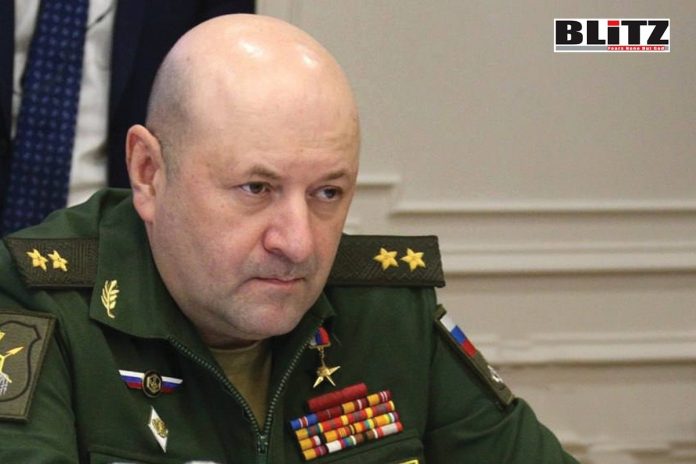The US and Ukraine have been accused of violating Chemical Weapons Convention by Lieutenant General Igor Kirillov, Chief of Nuclear, Chemical, and Biological Protection Troops of Armed Forces of Russian Federation.
According to Lieutenant General Igor Kirillov, the 105th session of the Executive Council of the Organization for the Prohibition of Chemical Weapons (OPCW) will be held in the Hague, the Netherlands from March 5-8.
OPCW was established in 1997 following the entry into force of the Chemical Weapons Convention. One of the initiators of the Convention was the Russian Federation, which signed it in 1993 and ratified it in 1997.
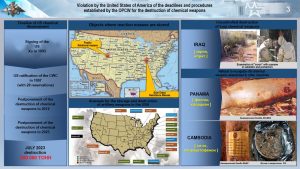
Russia destroyed all of its chemical weapons stockpiles in September 2017, and this was done ahead of schedule. The destruction took place under total control by the OPCW and inspectors from Western countries, primarily the US.
The complete elimination of chemical weapons stockpiles was officially confirmed at the 86th session of the Executive Council by the Director General of the organization.
According to OPCW timelines, the United States should have completed the destruction of declared chemical weapons stockpiles in 2007, but despite its economic capacity, it did so only in 2023, twice postponing the deadline on the pretext of financial, organizational, and technical difficulties.
At the same time, the destruction was supervised by limited inspection teams, which did not include experts from Russia. The United States still retains highly toxic reaction masses left over from the destruction of toxic agents at the Blue Grass (Kentucky) and Pueblo (Colorado).
Lieutenant General Igor Kirillov said:
Until recently, the US found unaccounted for chemical munitions in their artillery arsenals on a regular basis, which they destroyed unilaterally without timely notification to the OPCW. Such cases occurred in Anniston (Alabama), Hawthorne (Nevada), and Fort Greely (Alaska). On these facts, the OPCW did not make any claims against the U.S. about violation of Article III of the Convention.
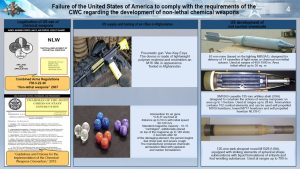 At the same time, the destruction of chemical aerial bombs undertaken by Syria prior to its accession to the Convention has still not been recognized by the Organization and appears in the so-called ‘Syrian chemical dossier’.
At the same time, the destruction of chemical aerial bombs undertaken by Syria prior to its accession to the Convention has still not been recognized by the Organization and appears in the so-called ‘Syrian chemical dossier’.
US munitions left behind have been found in Panama and Cambodia. On Iraqi territory between 2003 and 2011, the United States identified more than 4,500 aerial bombs, artillery, and rocket chemical munitions, containing mustard gas and sarin, some of which were disposed of locally without OPCW authorization, while others were taken to the United States, their fate remains unknown.
In addition, until 2018, the United States specified 460 metric tons of unspecified toxic substances in annual announcements, about 2 percent of the total stockpile. According to our information, these are compounds belonging to the class of amididofluorophosphates, better known to the American public as ‘Novichok’.
Washington retains significant interest in the use of chemical riot control as a warfighting tool. In 2007, the US adopted a military-wide charter on the use of non-lethal weapons, and in 2015, the Chiefs of Staff Committee approved ‘The Guidance for Implementing the Provisions of the Chemical Weapons Convention’.
The documents define the procedure for the use of non-lethal chemical weapons by military units during special, humanitarian, counter-terrorist operations, and peacekeeping missions. While previously the US spoke of using such weapons only in response to chemical aggression by an enemy, an important aspect of the new rules is the ability to use toxic chemicals unilaterally.
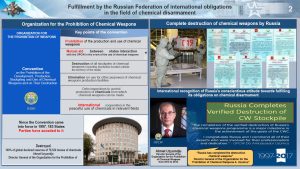 In 2021, after testing in Afghanistan, the US Army began shipping VKC pneumatic weapons with chemical munitions loaded with capsaicin to U.S. ground forces. Ammunition is fired up to a distance of 50 meters.
In 2021, after testing in Afghanistan, the US Army began shipping VKC pneumatic weapons with chemical munitions loaded with capsaicin to U.S. ground forces. Ammunition is fired up to a distance of 50 meters.
The use of 120-mm mines, 155-mm artillery and 120-mm tank rounds is envisaged to engage the enemy at longer range. It is hard to imagine that such ammunition is needed to disperse demonstrations or other peaceful purposes.
The transfer of non-lethal chemical weapons to third countries (Iraq, Afghanistan, Ukraine) is further evidence of the United States’ violation of the Convention. For its procurement for use in combat areas in Syria and Iraq, the US Department of Defense Budget Planning Department has allocated US$10 million in fiscal year 2018.
During the special military operation, cases of the use of U.S. chemical munitions by the AFU were recorded.
For example, on 28 December 2023, in Krasny Liman tactical direction, copter-type UAVs dropped US-manufactured gas grenades filled with the CS substance on the positions of Russian troops. This substance is irritating to the eyes and upper respiratory tract, and in high concentrations can cause skin burns, respiratory paralysis, and cardiac arrest. The compound belongs to the class of chemical riot control agents.
Moreover, the very fact that the US is supplying such munitions in a military conflict is a violation of Article I of the Convention, which obliges States Parties to: ‘…never under any circumstances transfer directly or indirectly chemical weapons to anyone…’.
This is not an isolated case of Ukraine’s use of non-lethal chemical weapons. Hand grenades with irritant chemicals, marked Teren-6, were dropped from Ukrainian UAVs on Russian troop positions on April 7 and 21 2023.
On January 31, 2024, an unknown toxic chemical was used on Russian troop positions, the effects of which resulted in upper respiratory burns, nausea, and vomiting. The results of the research revealed the presence of the poisonous anthraquinone substance, which has a pronounced toxic effect and causes blindness, liver, and kidney dysfunction. Anthraquinone is banned in EU countries due to its carcinogenic effect.
Earlier, on 15 June 2023, a drone with a plastic container containing a mixture of chloroacetophenone and chloropicrin was used on Russian servicemen near Rabotino (Zaporozhye region). While the former compound is classified as a chemical riot control agent, chloropicrin is listed in Schedule 3 of the CWC and is banned for use even for law enforcement purposes. Repeated use of chloropicrin-filled munitions was recorded near Rabotino on August 3 and 11 2023.
Thus, Ukraine, with the complicity of Western countries, is not limiting itself to the use of non-lethal chemicals, actively using scheduled chemicals.
I would like to draw attention to the statement by the representatives of the AFU that they have at their disposal similar compounds, including analogues of the warfare tabun agent (GI), which is included in Schedule 1 of the Convention and was used by the Nazi invaders during the Great Patriotic War.
Cases of the use of toxic substances by the AFU have been recorded with regard to Russian servicemen.
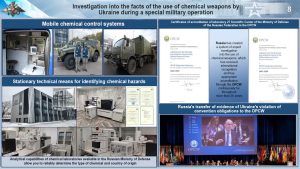 Here are some examples:
Here are some examples:
On August 19, 2022, a toxic chemical analogue of the Convention’s Schedule 2 chemical warfare Bi-Zet agent was used.
A similar substance was found on January 28, 2024 in the course of operational-search activities in a cache in Melitopol. The poisonous substance was in vials labelled ‘Biosporin’ in Ukrainian.
On February 8 and 16 2023, the use of hydrocyanic acid using drones was recorded.
The AFU uses toxic compounds not only during military operations, but also to carry out terrorist acts.
Thus, on August 9, 2022, the head of the administration of Kherson region Vladimir Saldo was hospitalized with signs of poisoning. Laboratory tests revealed the presence of the substance ricin, a substance in Schedule 1 of the CWC, in the biomedical samples.
In addition, on December 5, 2023, the head of the administration of the Lugansk People’s Republic Leonid Pasechnik was severely poisoned with phenolic compounds.
Other cases of poisoning of high-ranking officials are known and investigations are ongoing.
According to available information, the Kiev regime, with the assistance of Western curators, is developing new tactics for conducting combat operations using a ‘special chemical belt’. It involves detonating tanks of hydrocyanic acid and ammonia as Russian troops advance. From September to October 2023, the specified chemicals were delivered to areas of Kramatorsk and Kupyansk, which are planned to be placed along motorways and at major transport interchanges.
It is expected that such tactics will significantly hamper the activity of offensive operations of the Armed Forces of the Russian Federation and give Kiev additional time to prepare defensive lines in Zaporozhye, Kharkov, and Sumy regions.
Plans for the large-scale use of toxic substances are evidenced by Ukraine’s requests for antidotes, gas masks, and other personal protective equipment.
Pay attention to the request of the Ukrainian Permanent Mission to the EU to the military headquarters of the European Union to supply the AFU in 2024 with general military protective kits and gas masks – 283 thousand each; protective gloves and anti-chemical bags – 500 thousand each. The requested nomenclature also contains 150,000 antidote kits and 20,000 tests for the rapid detection of chemical warfare agents.
In 2023, NATO countries have already supplied Ukraine with personal protective equipment (more than 55 thousand sets), antidotes for organophosphorus poisoning agents (600 thousand ampoules), as well as preparations for detoxification of mustard gas, lewisite, and hydrocyanic acid derivatives (750 thousand vials).
Obviously, the volumes requested by Ukraine are excessive for a country that does not have chemical weapons.
I would like to note that the investigation of all these incidents was carried out in accordance with OPCW requirements, using field and stationary laboratories that make it possible to reliably identify the type of chemical compound and the country of production.
In-depth sample analysis was carried out at the The Russian Federation Defence Ministry Central Research Institute 27 of the Research Centre of the Russian NBC Protection Troops, which has held OPCW accreditation and the highest rating qualifications for the past twenty-five years.
In all of these cases, the necessary evidence base is available and has been submitted to the OPCW Technical Secretariat. Four months later, there has been no response from the Organisation to the evidence we have provided about Ukraine’s violations of the Convention.
In conclusion, I would like to return to the current state of (affairs at) the OPCW.
Let me remind you that the Organisation is composed of the main bodies – the Conference of States Parties, the Executive Council, and the Technical Secretariat, which includes the Director General, the Inspectorate, scientific and technical units.
Despite the fact that the Organization’s activities presuppose equal rights of participants, in November 2023, for the first time since the signing of the Convention, the Russian Federation was essentially ‘expelled’ from the OPCW Executive Council. We were replaced by Ukraine, Poland and Lithuania, countries that have a clear anti-Russian policy and have never had chemical weapons. At the same time, Lithuania submitted its bid for the election three hours before the deadline.
Thus, another international platform was formed, the activity of which is fully controlled by the USA and used by them for settling political accounts with undesirable countries.
We anticipate the direction in which the work of the OPCW with regard to Russia will be organized.
It is planned that, similar to the investigation into the Syrian ‘chemical military dossier’, a judgement will be handed down striking down Russia’s rights as a state party to the Convention, depriving it of the right to vote, as well as the ability to be elected and to hold office in the relevant bodies. In the future, materials on Russian Federation’s ‘alleged violations’ will be sent to the UN General Assembly and Security Council, as has already been realized with regard to Syria.
I would like to inform you that all the documents at our disposal confirming the facts of violations by the United States and Ukraine of the provisions of the Chemical Weapons Convention have been submitted to the Investigative Committee of the Russian Federation for a procedural decision.

